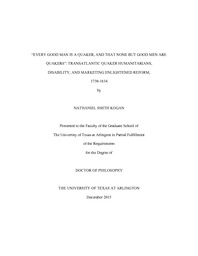
ATTENTION: The works hosted here are being migrated to a new repository that will consolidate resources, improve discoverability, and better show UTA's research impact on the global community. We will update authors as the migration progresses. Please see MavMatrix for more information.
Show simple item record
| dc.contributor.advisor | Rose, Sarah F | |
| dc.creator | Kogan, Nathaniel Smith | |
| dc.date.accessioned | 2017-09-05T19:15:25Z | |
| dc.date.available | 2017-09-05T19:15:25Z | |
| dc.date.created | 2015-12 | |
| dc.date.issued | 2016-02-24 | |
| dc.date.submitted | December 2015 | |
| dc.identifier.uri | http://hdl.handle.net/10106/26890 | |
| dc.description.abstract | This dissertation explores how Quaker humanitarians in the eighteenth and nineteenth centuries actively absorbed and employed emerging Enlightenment discourses about “disability” and human dependency as a means to build support for, fund, and market their reform activities.
Beginning in the eighteenth century in their abolitionist advocacy, Quakers harnessed Enlightenment rhetoric about disability and public displays of aberrant bodies and minds in order to raise attention to the plight of various marginalized groups and also to raise funds to support these causes. This emerging concept of disability, which was very individualized, cohered nicely with Quakers’ central theological tenet of the “Inner Light,” which holds that there is that of God in all individuals. Rooted in these earnest religious convictions and their embrace of Enlightenment progress, Quaker humanitarians absorbed the dualistic Enlightenment notion that disabilities constituted a marginal form of humanity, but one that an individual could overcome.
Methodologically, this dissertation takes a cultural approach by closely examining how Quaker reformers both adopted and adapted an Enlightenment-forged rhetoric of disability to market their reform endeavors, pursue their humanitarian goals, and define their sect as leaders in transatlantic philanthropy. Through this analysis, this dissertation highlights how Quaker reformers embraced an Enlightenment-forged concept of disability that was at once pejorative and celebratory. As philanthropic Friends marketed their own reform institutions and initiatives, they harnessed and often employed these Enlightenment ideas and rhetoric, thereby furthering this dualistic notion of disability. Defining institutional success through the medicalized language of “cures” and “restoration,” these philanthropists also helped reinforce Enlightenment hierarchies of disability. As a result, Quaker reform institutions actively sought out those aberrant people who could be “cured” and return to “normal” society, whom they felt constituted a higher form of humanity, while they sought to exclude those whose aberrance was permanent and not “bettered” by medical interventions or education. This dissertation focuses on the ways various Quaker reformers harnessed these ideas about disability to advocate for abolition, create more “humane” insane asylums, and influence the establishment of deaf education in Philadelphia.
Finally, this dissertation also uncovers the active role that many people with disabilities played both in the conceptual construction of disability in this era as well as in active resistance to the marginalization or exploitation that many institutional administrators tried to impose on them. | |
| dc.format.mimetype | application/pdf | |
| dc.language.iso | en_US | |
| dc.subject | Disability history | |
| dc.subject | Quakerism | |
| dc.subject | Quaker history | |
| dc.subject | Transatlantic history | |
| dc.subject | Transatlantic humanitarianism | |
| dc.subject | | |
| dc.title | “EVERY GOOD MAN IS A QUAKER, AND THAT NONE BUT GOOD MEN ARE QUAKERS”: TRANSATLANTIC QUAKER HUMANITARIANS, DISABILITY, AND MARKETING ENLIGHTENED REFORM, 1730-1834 | |
| dc.type | Thesis | |
| dc.date.updated | 2017-09-05T19:15:25Z | |
| thesis.degree.department | History | |
| thesis.degree.grantor | The University of Texas at Arlington | |
| thesis.degree.level | Doctoral | |
| thesis.degree.name | Doctor of Philosophy in Transatlantic History | |
| dc.type.material | text | |
| dc.creator.orcid | 0000-0003-1713-7903 | |
Files in this item
- Name:
- KOGAN-DISSERTATION-2015.pdf
- Size:
- 4.121Mb
- Format:
- PDF
This item appears in the following Collection(s)
Show simple item record


